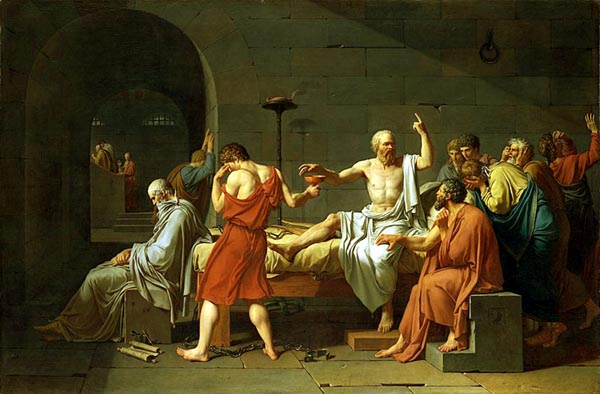 |
| The Death of Socrates (1787), by Jacques-Louis David (Wikipedia) |
Note: Socrates was executed for "corrupting the morals of the youth." Learn the story behind this "crime" and "see" how he died.
Get Ready: Do you think we should always listen to our parents, teachers, government leaders, and others in authority? Or should we question what they say to be sure it's the right thing?
Few individuals have affected the history of Western thought as profoundly as did the Greek philosopher Socrates, mainly through the writings of his student, Plato. And few paintings capture the impact of Socrates on his followers (and, ultimately, on us) better than the 1787 work of French painter Jacques-Louis David, The Death of Socrates.
In the painting, Socrates is sitting up on a bed, gesturing with one hand (still teaching!) as he reaches for a cup with the other. The person holding the cup is turned away and covering his face in grief.
Because the cup, you see, is filled with poison, and Socrates is drinking it as a form of execution by the state.
He had been tried and convicted on two charges: corrupting the youth of Athens, and impiety (worshipping false gods and not those of the state). The first charge resulted from his criticizing the leaders of Athens, and encouraging the youth to "question authority." Socrates denied that this was his intention. The second, which he freely admitted to in his trial, was because he deemed the gods, not like humans in nature, but more like concepts.
What had happened was this: a friend and follower of Socrates, Chaerephon, had gone to the Oracle at Delphi, and asked if Socrates was the wisest of men. The Oracle answered that no man was wiser than Socrates. When told this, Socrates doubted it, and began asking questions of prominent men in an effort to find one wiser than he was.
Alas, no one stood the test. Furthermore, the idle youth of the city began following him around and witnessing the disgrace of the leaders, which led to the charge that Socrates was "corrupting the youth."
Interestingly, in David's painting, Socrates is surrounded by grieving students (while his family waits outside in a hallway). Plato, anachronistically depicted as an old man, sits alone at the foot of his bed, while most of the others are crowded around the head. Their attitude stands in contrast to the confidence of Socrates, who had scolded them for their "womanly" signs of grief.
The man who has lived a moral life, he told them, had nothing to fear from death.
--------Read more: https://en.wikipedia.org/wiki/Trial_of_Socrates
Practice: Match the term to its definition below:
- anachronistically
- convicted
- corrupting
- deemed
- depicted
- disgrace
- idle
- impiety
- oracle
- prominent
- shown; portrayed
- found guilty
- shame; loss of respect
- lack of respect for sacred things
- a kind of fortune teller
- not working; hanging around
- in the wrong time period; here, at the wrong age
- important
- considered; thought (to be)
- leading astray; making immoral
Answers are in the first comment below.
Submitted to the Shenzhen Daily for July 15, 2021


Answers to the Practice: 1. g; 2. b; 3. j; 4. i; 5. a; 6. c; 7. f; 8. d; 9. e; 10. h
ReplyDelete